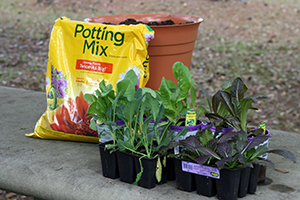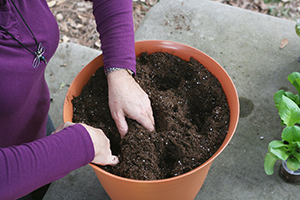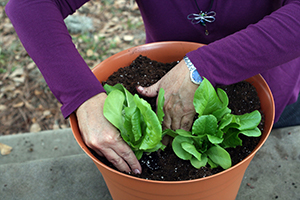Harvest as You Grow Container Gardening

Growing your own vegetables is becoming quite the popular hobby across the country. Container gardening allows anyone—from those with acres of land to apartment dwellers with no more than a tiny balcony—to try their hand at growing their own produce. This tutorial will walk you through the basics of creating your own “harvest as you grow” leafy greens container.
The best place to start is always with gathering your supplies. You’ll need a container; we used a 14-inch self-watering planter. When selecting a container, be sure to look for drainage holes, as a number of planters on the market seem to be made without any. If you find yourself with a container with no drainage, go ahead and add a couple yourself. You’ll also need potting mix. Make sure it’s potting mix and not potting soil. Of course, you’ll need plants; we suggest vegetable starts. In this example, we used ‘Buttercrunch’ Bibb lettuce, red romaine leaf lettuce, Japanese giant red mustard, and lacinato kale.

Once you’ve filled your pot with mix, plan out where to place the plants. You can simply use your hands to move the potting mix around and create small holes for each plant. We made five small holes around the perimeter of the pot and one in the middle.
Next, grab your plants and start planting! Even if your starts came in compostable planting pots, you can remove them. While the pot will break down in the soil, removing it allows the plant’s roots to spread more easily. (You can always put it into your compost pile, or even toss it under some bushes to break down naturally.)

Pay attention to how the roots of your starts look; if a plant looks root-bound, simply tease out the roots a little to help them grow.
For our pot, we planted two of the Bibb lettuces, two of the red lettuces, and two kale plants around the perimeter (we added a 6th perimeter hole). In the center we planted a one of the red mustard plants.
While typically these plants wouldn’t be planted this close together, we’re planning to continuously harvest leaves, so they won’t reach their fully mature sizes. With most leafy vegetables, the young leaves are the most tender and flavorful. Start harvesting your greens after four weeks and continue until the plants start to bolt (produce flowers).
You can substitute out any of the leafy greens (or reds) that we chose to ones that you would most enjoy. Remember, when planting a vegetable garden it’s important to plant vegetables that you’ll actually enjoy eating come harvest time!
